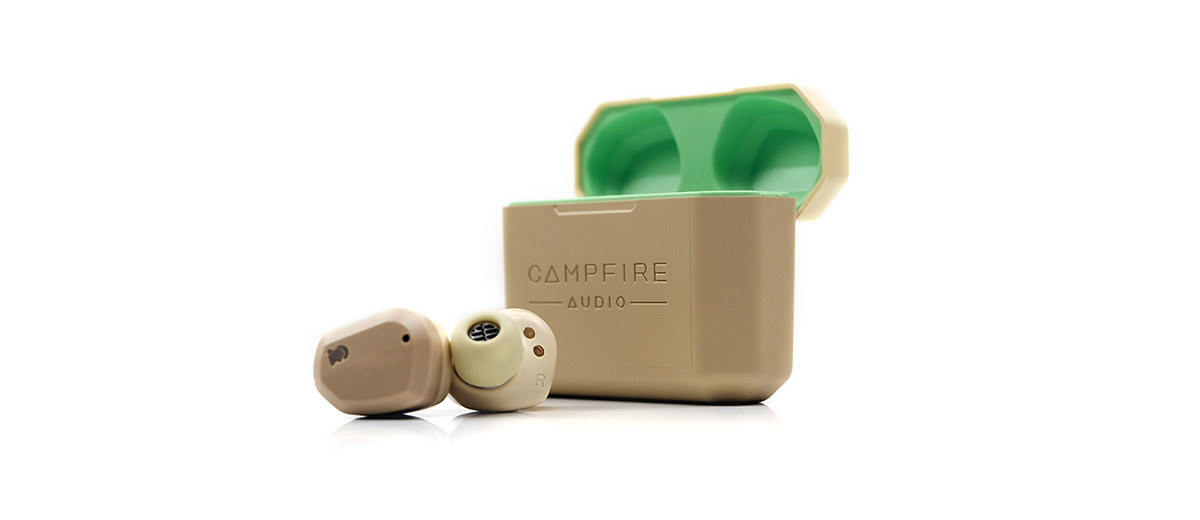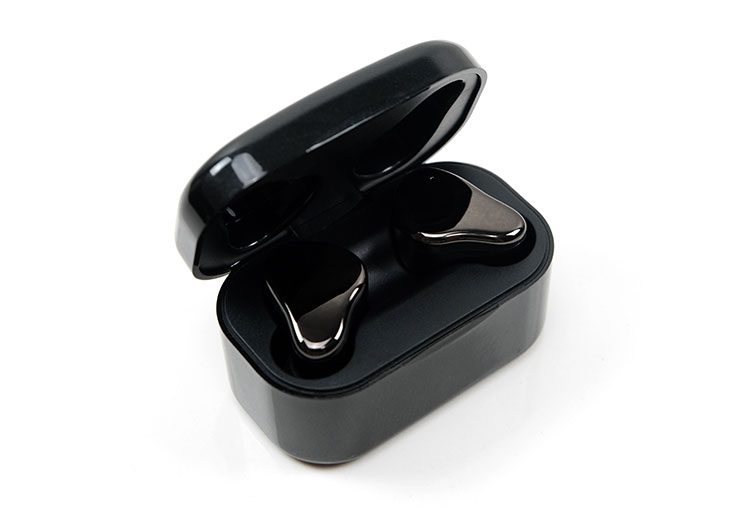Select Comparisons
The following comparisons were completed using each unit’s stock tips in combination with a Samsung Z Flip 3 and iPhone 13 Mini.
Noble Audio FoKus H-ANC
$199
Noble Audio has just released the FoKus H-ANC in 2022, our full review of it will be coming very shortly so these can be considered relatively early impressions.
Technical
The FoKus H-ANC is slightly different driver-wise. Rather than the Orbit’s single 10mm LCP dynamic driver this is a hybrid dual driver setup with a 10mm titanium membrane dynamic driver and a single Knowles’ RAN BA driver.
That means a mesh of driver timbres and a crossover inside the FoKus H-ANC, most likely split between low/mids and highs as opposed to all dynamic timbre performance from the Orbit.
The two TWS also use different BT SoC with a Qualcomm QCC-3040 SoC inside the Orbit and an Airoha 1562A FoKus H-ANC. Both are BT5.2 capable though the way the two companies have set them up there are some pros and cons.
For example, the Orbit does not have ANC which would be a plus for many, but the FoKus H-ANC will only decode up to SBC/AAC and not to the Orbit’s higher aptX Adaptive capability.
Despite the heavier burden of ANC, the FoKus H-ANC battery performance on paper is quite good at 8.5 hours with ANC and up to 12 hours without for the drivers. The Orbit is rated at 8 hours max though I do note Noble has not declared the testing conditions for that number.
Both cradles offer 30 hours of additional charge with USB-C with fast charging capability. However, brownie points to the CA Orbit for offering additional Qi wireless charging which is very handy for me personally.
Design
Both drivers look to be made out of ABS plastic but the aesthetics are quite different. The FoKus H-ANC has a two-tone mesh of purple and black which is a stark contrast to the faded creams and tans of the Orbit.
The form factor is quite different also. Noble has always been about depth and the H-ANC is no exception with a much longer nozzle behind a much wider body. The Orbit is much shallower and more reliant on the tip selection for passive isolation performance.
The H-ANC passively isolates better with that deeper insertion depth and that is before you turn on ANC which might be a deal maker for some potential buyers. I do give props to CA though for the superior tip selection with both foam and silicone whereas you only get one set of silicone with the H-ANC.
Both are touch-control devices with integrated app control though Noble has gone through a few generations of the FoKus app so it feels a bit more refined than the current Orbit app firmware version.
For example, the FoKus app offers a more in-depth EQ preset visual whereas the Orbit simply numbers them with no indication of what they are. Both do offer 10-band customizable EQ profiles for EQ though which I find useful.
Performance
Both TWS are aiming for something close to a V-shaped response curve though the immediate difference picked out was the comparatively cooler instrumental and vocal timbre with a higher level of sub-bass and sparkle from the Orbit compared to the warmer full-blooded tones of the H-ANC.
The Orbit seems to have a more pronounced 1-4k dip compared to the H-ANC which is then compensated for with a stronger 5-8k treble peak with the resulting midrange timbre cleaner but thinner sounding.
That dip also pushes back the Orbit’s vocal imaging a little more, especially for female performers but it does compensate with decent clarity and contrast from that treble tuning.
The H-ANC has a more neutral presentation in the mids, perhaps a very slight bump for vocal presence around 2-3k but still a bit south of a typical target curve. The treble is not as consistently elevated with a smaller upper treble peak so it sounds a little bit smoother in the highs.
Both have exaggerated low-ends so they hit hard with EDM, dance, and pop. However, the difference is in the level of warmth with the Orbit not carrying as much further up its FR compared to the H-ANC.
You could argue that the Orbit lacks the same fulsome mid-bass punch aiming for sub-bass prominence but you could also argue that the H-ANC is the more bloated of the two for mid-to-upper bass presence.
Pick your preferred sound signature in this case with the H-ANC the more vocal friendly for my tastes and the higher levels of contrasting lows and highs in the Orbit orientating more towards EDM sub-genres such as trance and synthwave.
Geekfly GF8s
$219
The Geekfly GF8s is one of those under-the-radar TWS with a complex design yet but with a similar price tag to the Orbit. You can read our full review of the GF8s here.
Technical
Like the Orbit, the GF8s is a non-ANC TWS and squarely aimed at the audiophile audience. Unlike the single 10mm LCP dynamic driver Orbit, the GF8s driver setup is much more complex.
Inside you get a titanium-plated 7mm dynamic driver for the lows and mids, a single balanced full-range armature for the mids and mid-highs, and a 10-layer piezoelectric ceramic tweeter for the super-highs.
All of which is threaded together inside a metallic acoustic chamber and using a physical 3-way crossover for phase alignment. Heck, there is even a Class A amplifier stuck in there for good measure so it’s not an SoC setup for amplification.
The Orbit is a newer device, however. Its Qualcomm SoC will output at BT5.2 whereas the GF8S stops at BT5.0. Decoding is also higher at aptX Adaptive on the Orbit as opposed to just SBC/AAC from the GF8s.
The Orbit also has an integrated app compatible with Android and iOS with EQ and some custom touch control abilities. The GF8s has none of that. It simply pairs and plays from whatever 3rd party media app you are using. Everything on the GF8s is fixed in stone so EQ will have to come from your app.
And finally, for battery life, that complex driver and Class A amp setup in the GF8s does have some drawbacks with just 5 hours available in the drivers with an additional 20 in the cradle. There is no wireless charging either.
The Orbit will outperform it at 8 hours per driver and with a better cradle life of up to 30 hours including fast charging and Qi wireless.
Design
The GF8s design is discreet but feels basic in materials and finishing for me. Don’t get me wrong, the shiny classic IEM contouring is nice but the polished feel is overdone a little and it can be very hard to grip when easing them out of the cradle as a result.
The matte tan and creams combo of the Orbit is a bit funkier and the finishing is a bit more concise. It looks like a well-thought-out and instantly recognizable design that is relevant to the CA brand. The GF8 is more anonymous-looking and could look like any IEM without a wire on it.
I go give the GF8 brownie points for its IEM-styled contoured shell which has better conformance to the natural shape of your ear compared to the shallower Orbit. The GF8s nozzle is not that long but the shaping and positioning are superior and do isolate a bit better as a result.
Neither of them has ANC so tips are important and both do offer a good range of choices with the GF8s offering 3 types of silicone single-flange and the Orbit offering silicone and foam depending on your preference.
Performance
The Orbit is more of a classic clean v-shaped response whereas the GF8s is a smoother and more relaxed curve with a stronger adherence to a Harman-type midrange.
What that means is that whilst both extend really well the Orbit has the snappier performance whereas the GF8s is the fuller and warmer-sounding low-end. You could argue the Orbit dynamic driver is a bit tighter with more contrast that helps give a bit more brightness to its snap.
On the flip side, the GF8S comes into its own with a more vocal-friendly level elevation of around 1-4k that stretches and opens up the mids a lot better. Vocals are stronger with a fuller tone, slightly more liquid on the attack, and offer a bit more textural detail.
The GF8s mids imaging also benefits from that lift pushing the vocals further forward though its strongest dip is in the lower mids so there is a bit of a gap there for instrumental presence.
Neither offers huge headroom but the Orbit does offer a stronger 5-8k treble lift whereas the GF8s is more relaxed in its 8k tuning. That in turn colors the GF8s timbre a bit more euphonic and warmer when combined with that obvious lift from 20Hz to 100Hz.
The Orbit timbre is much cooler in tone and anything around 2-3k is imaging further back creating more emphasis on that low-end fundamental and treble contrast. Mids can sound clean and very clear for classic EDM and Synth wave but not as prominent and as detailed as the GF8s for rock standards.
Samsung Galaxy Buds2 Pro
$229.99
The Buds2 Pro is positioned a bit closer to the consumer side of the market with its close alignment to Samsung’s smartphone range. That being said, at over $200 SRP, it’s not a casual purchase.
Technical
The Buds2 Pro has the power of a big business behind it so whilst it is more ‘consumer orientated’ it does come packed with a hell of a lot of tech and features.
For a start, both are dynamic driver models, the Orbit using a single 10mm LCP diaphragm version and the Buds2 Pro going with a 10mm woofer combined with a smaller 5.3mm tweeter. That 2-way is split between the lows for the 10mm and the mids/highs for the tweeter.
Both have a modern BT profile with the Orbit using BT5.2 and the Buds2 Pro bang up to date with the latest BT5.3 version. Neither offer LDAC decoding but instead opt for aptX Adaptive in the case of the Orbit and Samsung’s in-house Seamless codec supports up to 24-bit audio with a maximum bitrate of 512Kbps.
That is slightly higher than aptX Adaptive’s maximum of 419kbps but remember, this is only available on Samsung smartphones, not iOS or other Android phones.
The greatest asset for the Bud2 is its integration into the Samsung eco-system. The Samsung Wearables app is very in-depth with a massive array of options. This includes multiple ANC and ambient sound controls and even earbuds geo-tracking in sync with Google.
On the audio side, you have 360 audio and EQ, with the ability to seamlessly switch earbud connection with multiple devices connected to one Samsung account. It’s very well thought out and yes, the Orbit will not give you anything like that.
The Orbit does have some advantages over the Buds2 Pro such as a customizable EQ and perhaps very importantly, an app that is compatible with iOS. There is no applicable Samsung app for iPhones so you lose a lot of those features.
Design
The Buds2 Pro is small and cute, even more so than the Orbit, and for my tastes almost too small.
The IPX7 design is slick with various color schemes and very smooth to the touch with no edging anywhere. The purple one above stands out for me and is almost as niche as the retro IPX5 Orbit’s lime, tans, and creams.
The materials between the two do not feel much different with various plastics for both the driver and cradle. Rather it’s the finishing of the Bud2 Pro that just all the hallmarks of big money being thrown into it.
You have to remember Samsung has been developing the Buds range for a few years now so the Orbit has a bit of catching up to do.
The use of ANC on the Buds2 Pro is, in a way, a bit of a clever disguise because without it the passive isolation is not great, and not to the level of the Orbit with a well-matched set of tips. ANC pushes it past the Orbit and the additional Ambient mode for calls is useful also.
The comfort levels are great on the Buds2 Pro. They feel very light in the ear and perhaps more so than the Orbit but again, it’s the size and almost no nozzle that makes me concerned about how secure they are. The Orbit drivers do feel like they are more secure when moving around.
Battery life between these two is 8 hours each and using the Buds2 Pro without ANC. With ANC it drops to around 5 hours which is just average in terms of performance. Both cradles are good for up to 30 hours of additional battery life with both also offering wireless charging capability.
Performance
The Buds2 Pro is surprisingly more neutral sounding than I had expected, at least compared to the more dramatic curves of the Orbit tuning.
You do get a small lift in the lows on the Buds2 Pro up to 50Hz but nothing huge. It’s more of a punchy response with a reasonable fundamental but not overpowering and nowhere near as planted or as dominant sounding as the heftier Orbit bass presentation.
From there it’s a bit of a drop towards 1k with a corresponding 1-4k peak that just goes a shade north of neutral around 3-4k. Again, quite a contrast to the Orbit which carries more warmth up into the upper bass and some slight lower mids bloom before it drops to its lowest point around 2-4k.
That does mean the Buds2 Pro mids are much clearer and more in focus, particularly for vocals. It does sound more open through that midrange with some good imaging capability. The only caveat is the upper mids timbre which can have some partial treble overtones that can introduce some percussion sharpness.
I find that to be less the case with the Orbit’s upper mids unless you use the silicone tips which are brighter. The foam tips blunt any potential sharpness giving it a slightly softer presentation for percussion hits and higher-pitching vocal performances.
One caveat when comparing these two is your chosen source. The Buds2 Pro sounds competitive on a Samsung Phone with the seamless codec option activated. Once they drop down to SBC on other phones they can come across as a little lifeless.
Our Verdict
The Campfire Audio Orbit brings the CA team into what some might consider a completely new market for them. However, everything about this TWS screams Campfire from the fascinating blend of retro colors for the finishing to the instantly recognizable edging on the driver faceplate design. It is definitely going to stand out in this crowded market.
Importantly, it allows them to bring a level of experimentation in terms of tuning to a comparatively new audience. This is a big sound with a heavy punch and is surprisingly good for staging capability.
What does it lack? Well, the standout is ANC which I hope is something they will consider in any second-generation offering. The app is a good start though I suspect it can be fined tuned a little in terms of controls and EQ usability.
Still, the custom EQ works really well and since everything is firmware upgradeable I could see this being a short step to remedy.
Is it a purist neutral detail freak? No, this is not for those guys though I doubt at this stage if many TWS offerings will satisfy them. This is more for R’n’B, modern EDM lovers, or anyone who wants something livelier in its delivery.
Campfire Audio Orbit Specifications
- 5Hz–20 kHz Frequency Response
- Bluetooth 5.2 with Bluetooth LE Support
- Supported Codecs: SBC, AAC, AptX Adaptive
- USB-C Wired Charging and Qi Compatible Wireless Charging Case
- IXP5 Water Resistance Rating





